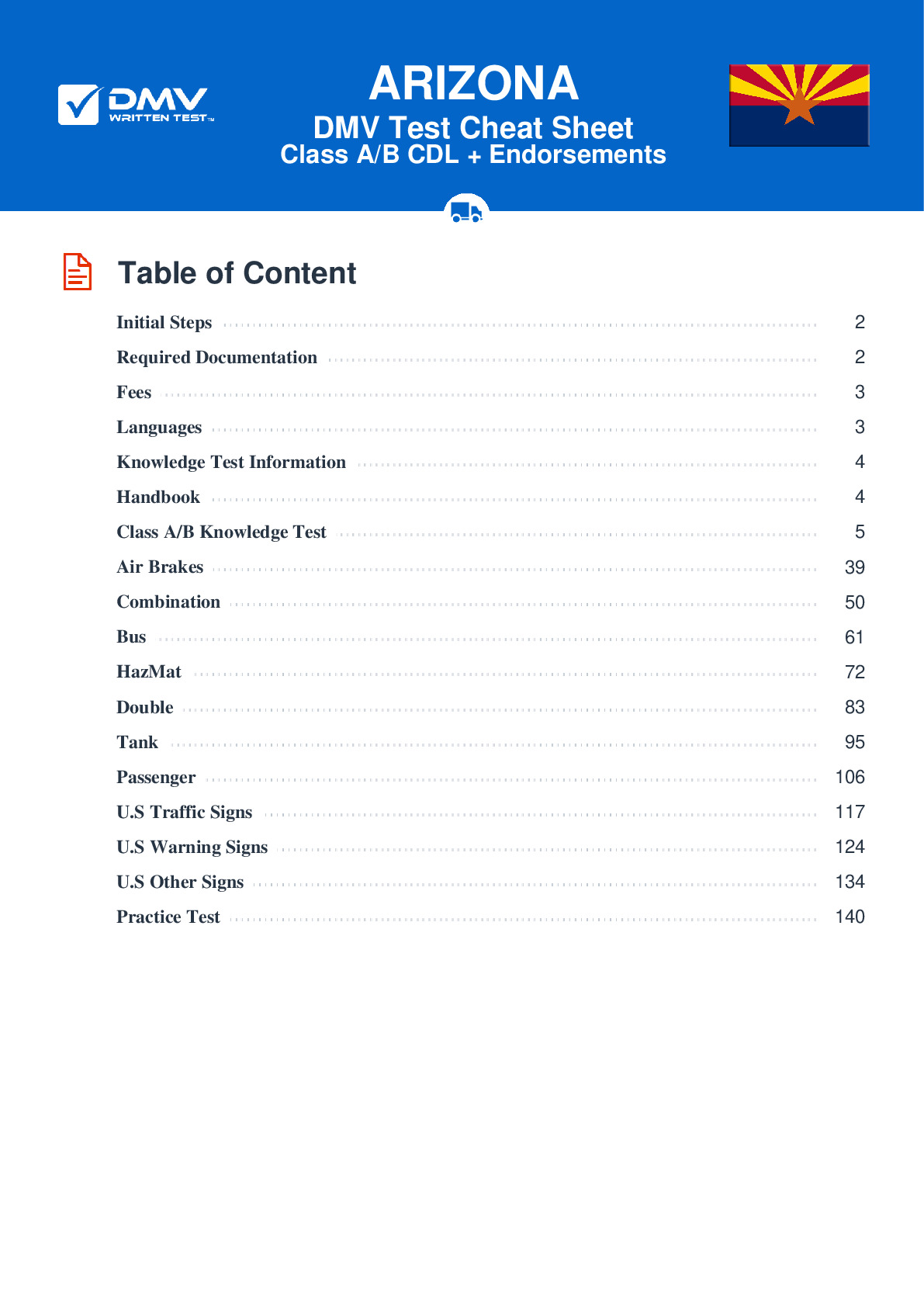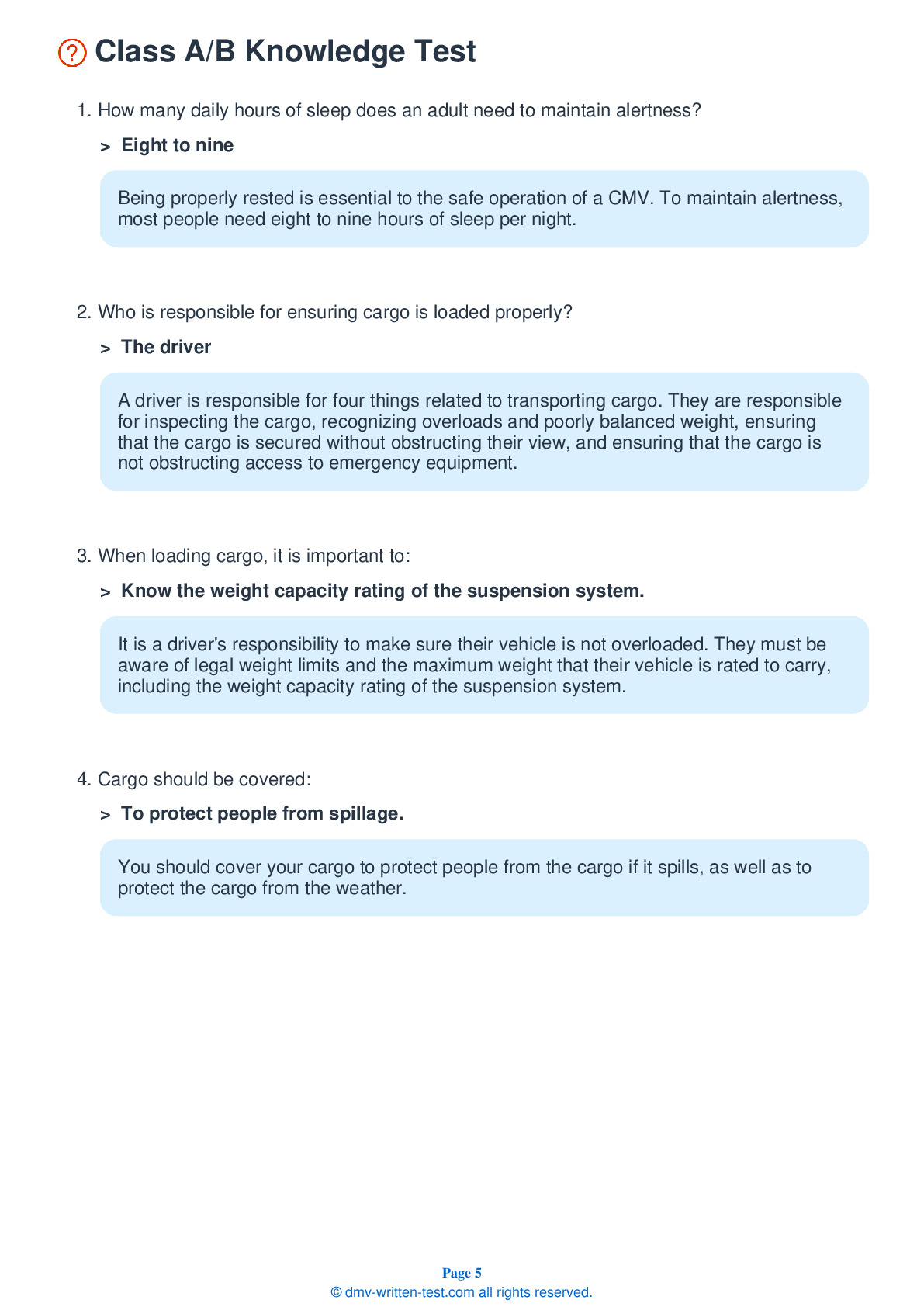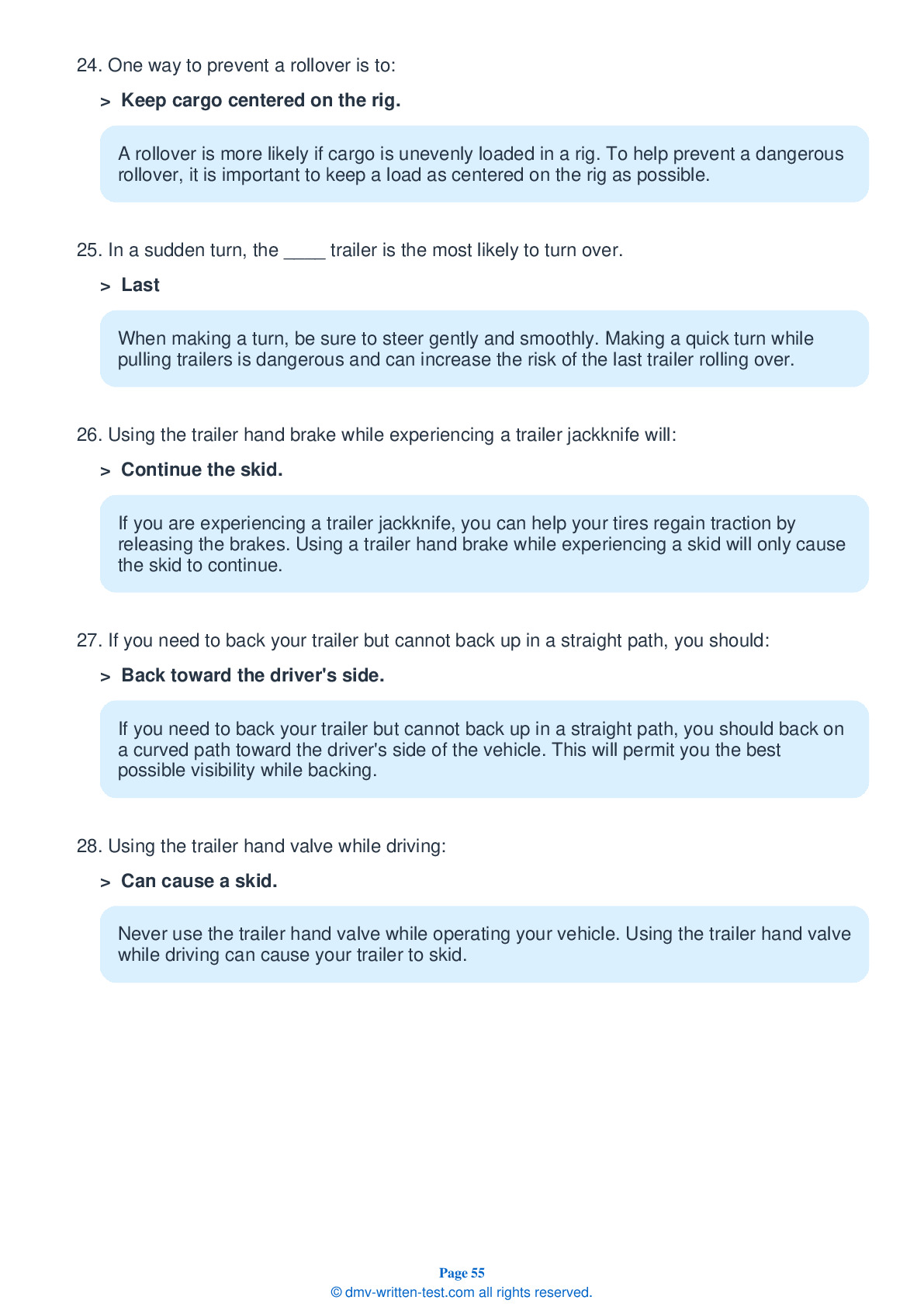Knowledge Test Class B
This license is required for driving a single vehicle with a GVWR of more than 26,001 pounds, and a trailer not to exceed 10,000 pounds gross vehicle weight rating, or a vehicle designed to transport 24 or more people (including the driver). To receive this license, applicants must pass a 50-question test. To pass, applicants must answer 40 questions correctly. Each question has three possible answer choices. Test questions come from the Arizona Commercial Driver License Manual. Questions come from chapters covering: Introduction, Driving Safely, Transporting Cargo Safely, Air Brakes (if applicable), Pre-Trip Vehicle Inspection Test, Basic Vehicle Control Skills Test and On-Road Driving.. Endorsements that may be used with a Class B CDL are: Hazardous materials, Tank, Passenger, HazMat and Tank, Air Brakes and School bus.
43. You may:
A person cannot have more than one driver license at a time. States share information through a computer database to ensure that no person has more than one license. Violation of this law could result in fines or jail time.
44. What should you do if your vehicle gets stuck on railroad tracks?
If your CMV gets stuck on railroad tracks, you should immediately leave the vehicle and get away from the tracks. Check the signposts or signal housing at the crossing for emergency contact information and call 911, or another appropriate emergency number.
45. If planning to change lanes, your mirrors should:
While regular mirror checks should be part of your normal scanning routine, be especially sure to check your mirrors when changing lanes.
46. If the brakes pull to one side or the other when used:
If the brakes pull to one side or the other when used, it is an indication of brake trouble.
47. In very hot weather, tires should be checked regularly because:
Because air pressure increases with temperature, you should pay special attention to the tire mounting and pressure when traveling in hot weather.
48. Roads are especially slippery right after it begins to rain because:
Roads are often especially slippery when it first begins to rain. Rainwater forms a slick film when mixed with oil and grease on the road surface that has not yet washed away.
49. When making a left turn, you should start the turn:
When making a left turn, you should wait until you reach the center of the intersection before actually beginning to turn. Due to off-tracking, the left side of your vehicle could hit another driver if you begin turning too early.
Frequently Asked Questions
To obtain a Class B CDL in Arizona, you must first obtain a learner's permit by passing a written test. You must then pass a skills test, which includes a pre-trip inspection, basic vehicle control, and on-road driving. You must also meet certain medical and vision requirements and provide proof of residency and identity.
Once you have obtained your Class B CDL in Arizona, you must follow all state and federal regulations related to commercial driving. This includes maintaining accurate logs of your driving hours and following all safety regulations when transporting hazardous materials. Additionally, you may be subject to regular drug and alcohol testing as part of your job requirements.
1. Single vehicles with a gross vehicle weight rating (GVWR) of 26,001 pounds or more, including passenger cars or other vehicles towing a trailer weighing less than 10,000 pounds.
2. Buses with a seating capacity of 16 passengers or more, including the driver.
3. Vehicles designed to transport hazardous materials in quantities that require placards.
Some examples of vehicles that you may be able to operate with a Class B CDL license in Arizona include delivery trucks, dump trucks, tow trucks, and buses. However, it's important to note that there may be additional endorsements or qualifications required for certain types of vehicles or cargo.
1. Be at least 18 years old (21 years old to operate interstate).
2. Hold a valid Arizona driver's license.
3. Pass a medical examination and obtain a medical certificate.
4. Provide proof of identity and residency.
5. Obtain a commercial learner's permit (CLP) by passing a written knowledge test.
6. Hold the CLP for at least 14 days before taking the skills test.
7. Pass a skills test, which includes a pre-trip inspection, basic vehicle control, and on-road driving.
8. Pay the required fees.
In addition to these requirements, you will also need to meet any additional qualifications or endorsements required for specific types of vehicles or cargo. For example, if you plan to transport hazardous materials, you will need to obtain a Hazardous Materials (H) endorsement by passing an additional knowledge test and undergoing a security threat assessment.
If you plan to drive a commercial motor vehicle across state lines, you must be at least 21 years old. This is due to federal regulations set by the Federal Motor Carrier Safety Administration (FMCSA).
1. Passenger (P) endorsement: required to drive a vehicle designed to transport 16 or more passengers, including the driver.
2. School bus (S) endorsement: required to drive a school bus.
3. Tank vehicle (N) endorsement: required to transport liquid or gaseous materials in a tank or tanks having an individual rated capacity of more than 119 gallons and an aggregate rated capacity of 1,000 gallons or more.
4. Hazardous materials (H) endorsement: required to transport hazardous materials as defined by federal law.
To obtain an endorsement, you must pass a written knowledge test and in some cases, additional skills tests or background checks. It is important to note that some endorsements may also require additional fees and training.
1. Pre-trip inspection: You will be asked to inspect your vehicle and demonstrate your knowledge of the vehicle's safety components and operation. You will be required to explain and demonstrate how to inspect items such as the engine compartment, tires, brakes, lights, and more.
2. Basic vehicle control skills: You will be tested on your ability to control the vehicle in various situations. This may include backing up in a straight line, making tight turns, stopping smoothly, and more.
3. On-road driving test: You will be evaluated on your ability to safely operate the vehicle on public roads. You will be asked to drive in various traffic situations, including intersections, turns, lane changes, and more.
It is important to note that the specific requirements for the Class B CDL skills test may vary depending on the state you are in. Be sure to check with your local Department of Motor Vehicles for specific details about the skills test.
1. Vehicle type: A Class B CDL license allows you to operate a single vehicle with a gross vehicle weight rating (GVWR) of 26,001 pounds or more, or a combination of vehicles with a GCWR of less than 26,001 pounds (towing a trailer with a GVWR of less than 10,000 pounds). You are not allowed to operate a combination of vehicles with a GCWR of 26,001 pounds or more.
2. Passenger and hazardous materials: If you do not have the required endorsements, you are not allowed to transport passengers or hazardous materials.
3. State-specific restrictions: Some states may have additional restrictions or limitations for Class B CDL license holders. For example, some states may require additional endorsements or restrict driving during certain hours.
4. Medical certification: You are required to have a valid medical certificate to operate a commercial vehicle. The medical certificate must be renewed every two years.
It is important to note that the specific restrictions and limitations for Class B CDL license holders may vary depending on the state you are in. Be sure to check with your local Department of Motor Vehicles for specific details about Class B CDL license restrictions and limitations in your state.
If you are not comfortable taking the test in English, it is important to check with your local Department of Motor Vehicles to find out if the test is available in your preferred language. If it is not, you may need to take steps to improve your English language skills before taking the test.
It is also important to note that even if the written test is available in a language other than English, you will still need to be able to communicate effectively in English to pass the overall CDL exam. This is because the CDL exam includes a skills test that requires verbal communication with an examiner.
To request accommodations for the Class B CDL written test, you will need to contact your local Department of Motor Vehicles and provide documentation of your disability. The DMV will then work with you to determine what accommodations are appropriate based on your specific needs and the requirements of the test.
Examples of accommodations that may be provided include extended time to complete the test, a separate testing room, a reader or interpreter, or a Braille or large-print version of the test. The specific accommodations provided will depend on your individual needs and the resources available at your local DMV.
It is important to note that you will need to make your request for accommodations in advance of the testing date so that the DMV has time to make arrangements.
In most states, you will need to pay a fee for each retake of the test. It is important to study and prepare thoroughly before taking the test again to increase your chances of passing.
If you fail the written test multiple times, you may be required to take a CDL training course before being allowed to retake the test. This can be a significant expense and time commitment, so it is important to take the preparation and studying for the test seriously.
It is important to note that if you fail the skills or road test required for obtaining a CDL, you may need to wait even longer before being allowed to retake the test. This waiting period can be several months or more.




